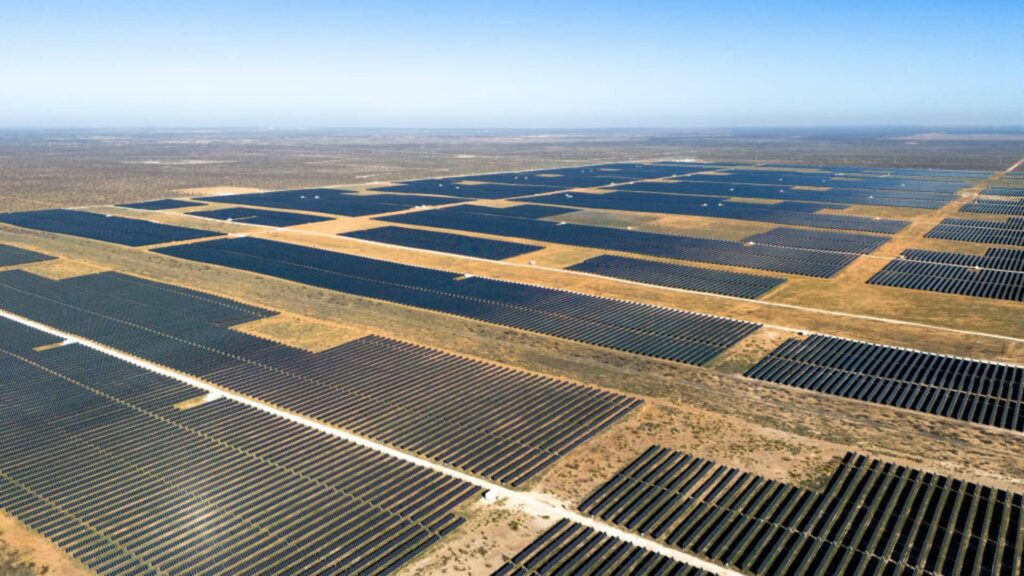The United States has witnessed a surge in solar energy as power demand increases, surpassing the growth of all other electricity sources. Despite criticism from oil and gas industry leaders, the clean energy sector is reaching a turning point, driven by the demand for renewable energy solutions from large tech firms like Amazon and Microsoft.
Although solar energy only accounted for 3.9% of the nation’s power mix in 2023, compared to the 43% share held by natural gas, this is expected to change. Large tech companies have invested heavily in clean energy to power their data centers, which are essential for internet and artificial intelligence applications. This is due to the declining price of solar modules and batteries, which make renewable energy more economical.
Renewable Energy: The Future of Power Generation
Andrés Gluski, CEO of AES Corporation, a power company that operates both renewable and gas-powered plants, believes that renewable energy is the future. AES Corporation has signed large power agreements with major companies like Google and Amazon.
Amazon, Microsoft, Meta Platforms, and Google represented 40% of the demand for large, utility-scale solar projects in the U.S. over the past five years. With these companies committed to 100% clean energy, demand for renewable solutions is set to grow, especially with the increasing energy requirements of artificial intelligence applications.
Renewable Energy Dominates Future Installations
Solar energy is forecast to comprise 58% of new electricity generation installed in the U.S. in 2024, according to an estimate from the Department of Energy. An all-time high of 36 gigawatts of solar power is scheduled to be added to the grid this year, nearly double last year’s increase. By contrast, only 2.5 gigawatts of natural gas is expected to be installed in 2024, marking the lowest number in 25 years.
Increasing Power Usage
The U.S. is experiencing a historic rise in electricity demand due to a return of manufacturing to the U.S., increased electric vehicle adoption, and the building out of energy-intensive data centers by Big Tech companies. These trends could lead to a 20% surge in electricity demand by 2030. This increased demand poses a challenge to achieving the Biden administration’s goal of 100% clean electricity by 2035.
Rising Solar Energy Adoption
Despite the arguments of natural gas producers that they are better equipped to meet the increasing demand, the clean energy sector is experiencing a boom. In 2023, nearly 2,500 gigawatts of solar, wind, and battery projects were requesting connection to the power grid – double the entire installed capacity of the current U.S. power plant fleet. Solar energy demand is expected to continue rising as the cost of solar for large utility projects becomes competitive with natural gas.
Challenges for the Renewables Sector
While renewable energy is on the rise, the sector faces significant challenges. Achieving 90% clean electricity by 2035 would require a threefold increase in the deployment rate of renewables. Additionally, the construction of necessary physical transmission lines poses significant logistical challenges due to complex permitting across various administrative levels.
Role of Batteries
Batteries play a crucial role in ensuring renewable energy can meet demand during non-peak weather conditions. Current lithium-ion batteries can typically store four hours of power. However, to provide reliable power throughout the day, batteries that can store eight hours or more of power are needed. The cost-effectiveness of longer-duration batteries is expected to improve as energy demand increases.
Companies like Fluence, one of the leading battery providers for utility-scale projects in the U.S., are optimistic about the future of battery storage. The company’s president of the Americas region, John Zahurancik, notes that battery costs have decreased by approximately 20 times since the early 2000s and expects the value of each additional hour of battery storage to rise as energy demand increases.
It is clear that renewable energy, particularly solar, is set to play a significant role in the future of power generation in the U.S. as the demand for clean, sustainable power continues to grow.
Original Story at www.cnbc.com
